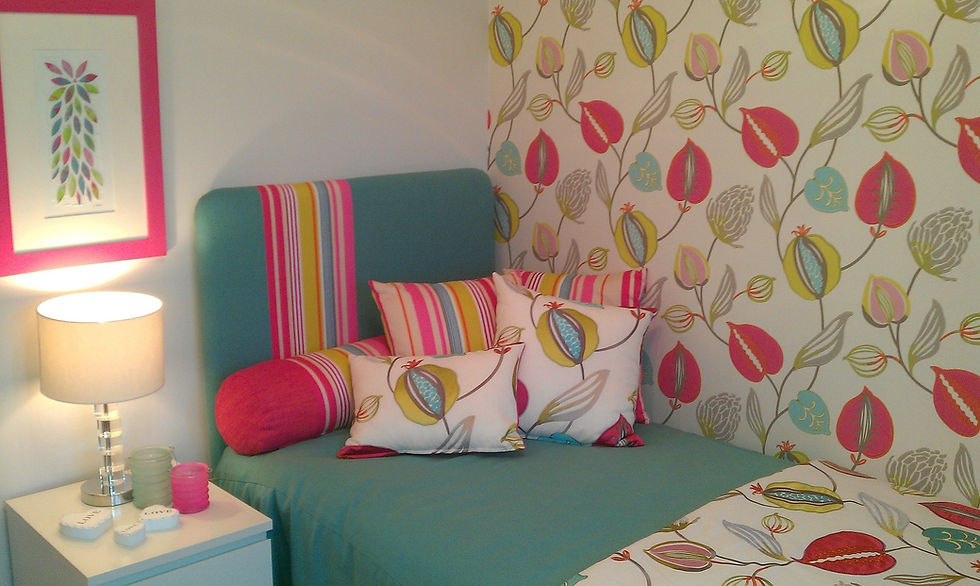11 Wallpaper Tips
- Strong Tower Renovations

- Aug 10, 2018
- 4 min read

The decision to hang wallpaper in your home might be scary for beginners, but it doesn’t have to be if you keep a few things in mind before you start. Read through our list of tips and you’ll be well on your way to hanging wallpaper like a pro.
Ordering
Order all of the wallpaper you’re going to need (and then some) at the same time. When it arrives, take time to double check the lot numbers to ensure it all came from the same batch or run. Different runs can have a slightly different coloration in the printing and won’t always match, which can look a bit off once you get it up on your walls.
Lining Paper
You should consider hanging a medium-weight lining paper before installing your wallpaper. The lining paper will prevent the wallpaper from creasing or stretching and will also help the paste dry faster. Another added bonus is that it will give you good practice for hanging paper if you’re just learning how.
Hide Alignment Mistakes
Before you start to hang wallpaper over dark paint or existing wallpaper, apply a one-inch strip of white paint along the top of the wall before you begin. If your wallpaper fails to align just right at the top of the wall, it won’t be as noticeable with the paint strip.
Get Your Tools
Locating, purchasing and having all your tools present before you begin to hang your wallpaper will be a big time-saver. The tools you will need include the following:
Seam roller
Wallpaper smoother or brush
Level
Push pins
Tape measure
Scissors
Long painter’s tray filled with lukewarm water
Wet sponge
Bucket of water
Broad putty knife
Utility knife.
When it comes to your pasting table, try using plastic instead of newspaper to cover the surface. The ink from the wet newspaper could stain the wallpaper and make it unusable. Don’t take the risk and cover your pasting table with a plastic tablecloth or drop cloth instead.

Using a Plumb Bomb
From a distance, corners might seem like perfect right angles, but more often than not the corner of the walls is usually a few degrees off from a perfect right angle. The only way to ensure that your wallpaper is straight is by making a plumb line from where you measure the alignment of the paper. You can achieve this by using a device known as a plumb bomb or a carpenter’s level.
If you’ve used the plumb bomb to make your first line, keep a carpenter’s level handy. Use it to double check that the wallpaper is straight. If you don’t, it could be several strips too late by the time you notice the error. A carpenter’s level can also help you cut straighter lines when you’re cutting from the roll.
Matching Patterns
The first wallpaper strip you cut should be about four inches longer than the height of the wall you’re going to apply it to. Strips cut after this should be at least two inches longer on the top and bottom and sometimes longer than the first strip to make sure that the pattern matches up.
Lay Cut Strips on the Floor
After you’ve measured and cut the first strip — and you’re confident that it’s the correct size — lay it out flat on the floor and measure the next strip. Make sure there is enough space at the top and bottom of the second strip so that the pattern lines up correctly with the first strip. You can use a paper to mark the back of the wallpaper if you are going to cutting several strips at a time. Using a pencil ensures that the marking won’t disappear when the paper gets wet. Laying the strips out on the floor is a much easier solution than trying to lay them out on the walls and keeping them organized.
Book strips in Plastic Bags
When booking a strip (allowing the strip to relax or breathe after the adhesive has been activated with water) enclose it in a large plastic bag. This will help in preventing your paper from drying out. This is also helpful if you plan on booking several strips at once.
Watch the Power
Cut the power to the room you’re working in before papering around switches and receptacles. Remove all covers. Then, begin to paper over them as if they were not there. Make a diagonal slit from opposite corners of the openings and trim away the triangular flats once you paper the entire wall. After it’s been set, just replace the covers.
Double Check, Again
Double or even triple-check newly placed strips for bubbles and seam matches. Bubbles need to be smoothed out as quickly as possible and seams can be adjusted before the adhesive has set in for too long.
After placing a strip on the wall use your sponge to wipe away any excess adhesive from the wallpaper, ceiling and baseboards. Make sure you rinse the sponge often and thoroughly between each use to remove as much glue as possible before moving on to the next section.

Sharpen & Trim Carefully
Before you begin to trim the excess paper from the wall, make sure your utility knife is sharp. Dull knives or blades will cause the paper to tear and can lead to uneven lines or damaged wallpaper.
Keeping a broad putty knife flush between the wallpaper and the blade when trimming will protect the paper and ensure a straight cut. Be sure not to lift the blade until you’re completely done with the cut.



Comments